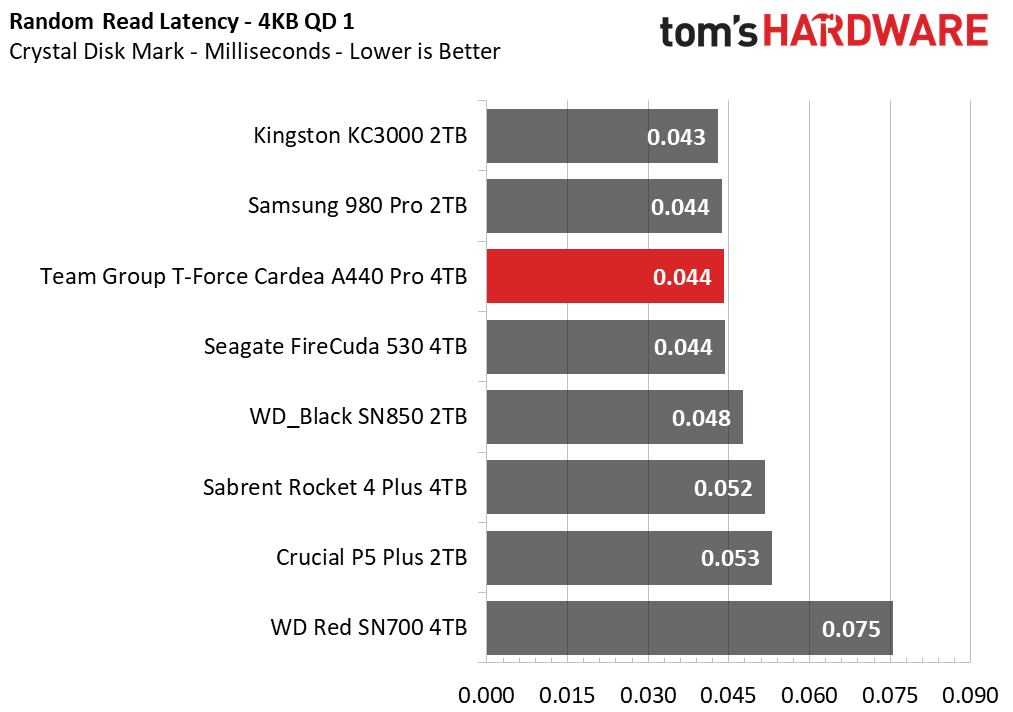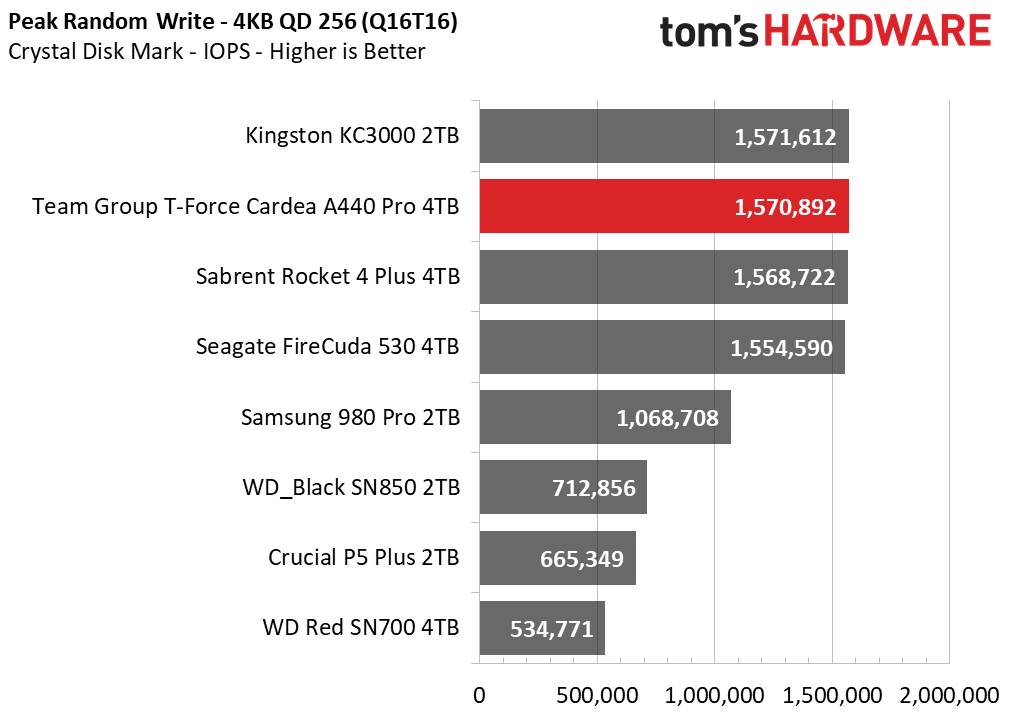Why you can trust Tom's Hardware
4TB A440 Pro Special Series
Rating: ★★★★ ½ (Editor's Choice)
Verdict: The 4TB A440 Pro Special Series did not disappoint - this is a premium drive that is particularly good at 4TB.
FOR
+ High overall performance, and as expected
+ 4TB pricing for a drive of this quality is competitive
+ Conservative SLC caching design has faster, more consistent overall performance
+ Runs sufficiently cool and is efficient
AGAINST
- None
Get Tom's Hardware's best news and in-depth reviews, straight to your inbox.
Comparison Products
We compared the 4TB Team A440 Pro Special Series to 4TB drives like the Seagate FireCuda 530, the Sabrent Rocket 4 Plus, and WD’s Red SN700, the first two being drives hosting comparable hardware. We’re also testing against popular 2TB PCIe 4.0 drives like the WD Black SN850, Crucial’s P5 Plus, the Samsung 980 Pro, and lastly another E18-based 176-layer entry with the Kingston KC3000.
This field of drives lets us see if the A440 Pro Special Series stands out from a crowd of its peers, keeping in mind that its current price point for the 4TB capacity is quite competitive in the PCIe 4.0 SSD market.
Trace Testing - 3DMark Storage Benchmark
Built for gamers, 3DMark’s Storage Benchmark focuses on real-world gaming performance. Each round in this benchmark stresses storage based on gaming activities including loading games, saving progress, installing game files, and recording gameplay video streams.



The results of our 3DMark tests are as expected for this drive, notably without any anomalies like we saw with the 2TB A440 Pro. The 4TB A440 Pro Special Series performs in line with the other E18-based drives that use Micron’s 176-layer TLC flash.
Trace Testing – PCMark 10 Storage Benchmark
PCMark 10 is a trace-based benchmark that uses a wide-ranging set of real-world traces from popular applications and everyday tasks to measure the performance of storage devices.



The drive also matches expectations in PCMark 10, although results are a bit lower than with the direct competition in the 2TB Kingston KC3000. One reason is that there is a peak performance capacity for drives dependent on the controller and flash used. While with past generations, 2TB was not always as fast as 1TB in all benchmarks, we’re slowly moving towards 2TB being the peak sweet spot.
Interleaving tends to be best at around four dies per channel, which with the eight-channel Phison E18 and 64GB dies would be at 2TB. Previous generations of TLC flash were 32GB per die, often with 64GB options that were slower in some metrics, but Micron’s 176-layer B47R flash is natively 64GB. Of course, Micron’s 96-layer B27A and B27B - the latter especially popular with early E18 drives - were 64GB per die, although their lineage was found in the 64-layer, 64GB B17A which was effectively two 32GB B16A dies put together.
The ability to scale flash is one benefit of new, higher-layer generations, although this also means that lower-capacity drives are reliant on multi-planar interleaving as there will be fewer overall dies; these parallelization types are not precisely equal. These technical details are not super relevant to the general user but are worth considering when looking at edge capacities.
Transfer Rates – DiskBench
We use the DiskBench storage benchmarking tool to test file transfer performance with a custom, 50GB dataset. We copy 31,227 files of various types, such as pictures, PDFs, and videos to a new folder and then follow-up with a reading test of a newly-written 6.5GB zip file.


Performance is as expected here. Note that the recently-reviewed 4TB WD Red SN700 falls behind since it’s a PCIe 3.0 drive, but also that it costs about half as much for that capacity. NAS NVMe caching drives are often used in pairs, and that cost starts to add up.
Synthetic Testing - ATTO / CrystalDiskMark
ATTO and CrystalDiskMark (CDM) are free and easy-to-use storage benchmarking tools that SSD vendors commonly use to assign performance specifications to their products. Both of these tools give us insight into how each device handles different file sizes.














The 4TB A440 Pro Special Series is on top in ATTO, particularly with larger block sizes, as we see with other E18-controlled drives. In CrystalDiskMark, however, we see a return to normalcy from the 2TB A440 Pro, demonstrating the difference in performance created by different types of flash. This again is predominantly with small random reads. Note that we still see a decline in places but these match those of the 4TB FireCuda 530, for the reasons mentioned above. Solid results here, especially with the all-important 4KB QD1 random read metrics.
Sustained Write Performance and Cache Recovery
Official write specifications are only part of the performance picture. Most SSDs implement a write cache, which is a fast area of (usually) pseudo-SLC programmed flash that absorbs incoming data. Sustained write speeds can suffer tremendously once the workload spills outside of the cache and into the "native" TLC or QLC flash. We use Iometer to hammer the SSD with sequential writes for 15 minutes to measure both the size of the write cache and performance after the cache is saturated. We also monitor cache recovery via multiple idle rounds.





We see fairly excellent results for sustained writes with the 4TB A440 Pro Special Series. The cache is about twice the size of the 2TB A440 and we predictably hit a high direct-to-TLC performance zone once the SLC caches runs out. However, the peak performance of that zone is closer to what we saw in 2TB E18 previews, showing the limits of Micron’s 176-layer flash with full interleaving.
Although the precise die speeds of B47R are not publicly documented, latency and throughput are likely similar to 176-layer TLC efforts from Micron’s competitors, which would put it in the 40-42 MBps per plane range. Micron’s architecture is closest to what we see with Samsung’s 8th-Generation V-NAND which was shown off at this year’s ISSCC. In any case, the advantages of fast native flash are illustrated in these charts, hitting beyond PCIe 3.0 limits - a level of write throughput that would have required 2-bit MLC in the past.
The drive still hits a third, slower state, but even this is quite fast by recent standards. It’s worth noting here that while SLC performance is important for writes, native flash performance is useful for reads - your stored data will be in native mode - and also gives a better indicator of steady state response. Ultimately you are limited by the native flash so having B47R over, say, B27B, can be significant when looking at edge cases and performance pitfalls. That’s not to talk about other characteristics like efficiency.
In any case, sustained write performance is often a requested test for SSDs, coming along with the dismissal of any drives that lack DRAM. Newer DRAM-less NVMe drives have proven to buck this trend. Likewise, you may never really see the post-SLC experience. However, this is at least partially due to faster flash, which can be revealed with this type of testing and further, when buying a premium drive you want to be sure you’re getting what you ordered. Comparing the results here to the media grade 2TB A440 Pro helps illustrate this point, but also seeing similar hardware with different caching schemes gives a better picture of the overall design.
Recovery matched what we saw with the 2TB A440 Pro, although again the smaller cache design ensures a certain level of relatively high TLC performance.
Power Consumption and Temperature
We use the Quarch HD Programmable Power Module to gain a deeper understanding of power characteristics. Idle power consumption is an important aspect to consider, especially if you're looking for a laptop upgrade as even the best ultrabooks can have mediocre storage.
Some SSDs can consume watts of power at idle while better-suited ones sip just milliwatts. Average workload power consumption and max consumption are two other aspects of power consumption, but performance-per-watt is more important. A drive might consume more power during any given workload, but accomplishing a task faster allows the drive to drop into an idle state more quickly, ultimately saving energy.
We also monitor the drive’s temperature via the S.M.A.R.T. data and an IR thermometer to see when (or if) thermal throttling kicks in and how it impacts performance. Remember that results will vary based on the workload and ambient air temperature.




Efficiency at 4TB is not going to be as high as with 2TB with these drives, as we see from the 4TB Rocket 4 Plus and the 4TB FireCuda 530 in comparison to the 2TB KC3000. Being able to finish the job quicker thanks to the PCIe 4.0 interface can actually improve efficiency, too. The 4TB A440 Pro Special Series ran noticeably hotter than the 2TB A440 Pro, as anticipated earlier by comparing their native cooling solutions. This drive ran upwards of 20C higher and flirted with a throttling floor but on the whole did not have many issues, which is not surprising given our earlier FURY Renenage review results.
Test Bench and Testing Notes
| CPU | Intel Core i9-11900K |
| Motherboard | ASRock Z590 Taichi |
| Memory | 2x8GB Kingston HyperX Predator DDR4 5333 |
| Graphics | Intel UHD Graphics 750 |
| CPU Cooling | Alphacool Eissturm Hurricane Copper 45 3x140mm |
| Case | Streacom BC1 Open Benchtable |
| Power Supply | Corsair SF750 Platinum |
| OS Storage | WD_Black SN850 2TB |
| Operating System | Windows 10 Pro 64-bit 20H2 |
We use a Rocket Lake platform with most background applications such as indexing, windows updates, and anti-virus disabled in the OS to reduce run-to-run variability. Each SSD is prefilled to 50% capacity and tested as a secondary device. Unless noted, we use active cooling for all SSDs.
Conclusion
We didn't talk much about the non-E18 competitors in the WD Black SN850, the Samsung 980 PRO, and the Crucial P5 Plus. One reason is that we’ve fully compared these products in the past to E18 drives with both 96- and 176-layer flash, not to mention at multiple typical capacities. Here we’re looking at something different with a 4TB model. As for those competing drives, we’ve already shown that optimization can vary — for example in our recent FURY Renegade review.
The A440 Pro and A440 Pro Special Series are not bad drives. They’re in fact quite fast and the 4TB option is a nice one to have. The cache design is more conservative which in many ways provides a more consistent experience across wide drive usage.
Pricing is competitive at 4TB, but it’s worth noting that SSD drives, including and especially with PCIe 4.0 options, have come down a lot in price recently, particularly at the 1TB and 2TB capacity points. The A440 Pro in particular ran very cool, also, which might make it a good choice for some people. Although we’re not fans of Team’s SKU spam, we do like these drives.
MORE: Best SSDs
MORE: How We Test HDDs And SSDs
MORE: All SSD Content

Shane Downing is a Freelance Reviewer for Tom’s Hardware US, covering consumer storage hardware.